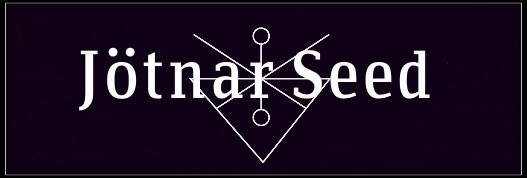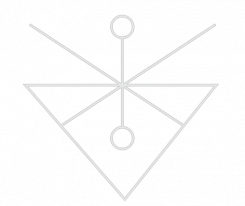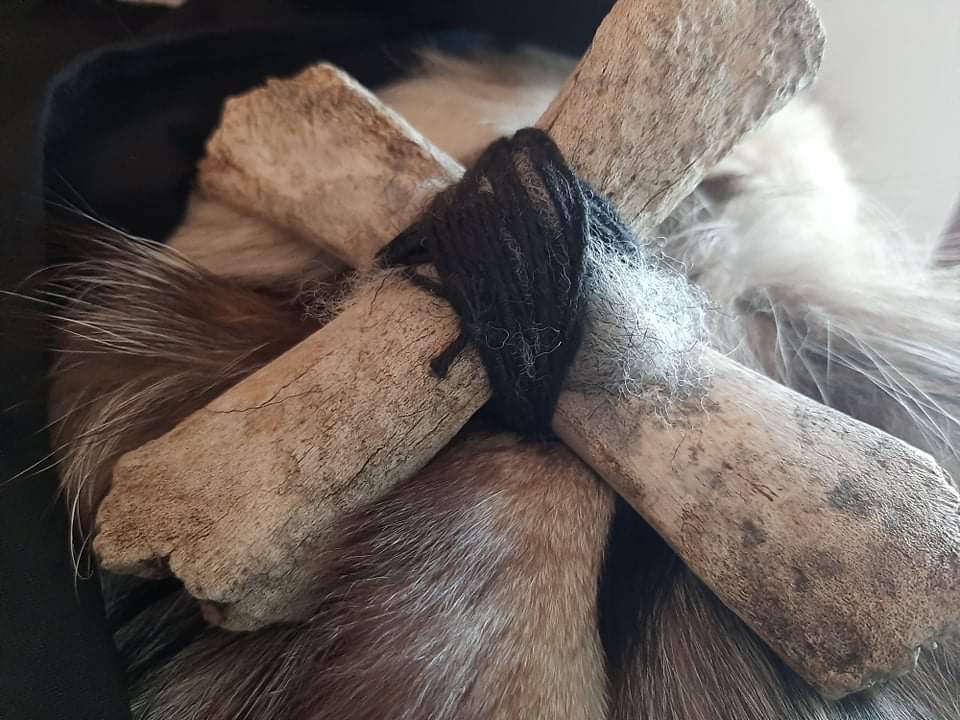The purpose of this article is to show how different facets have broadened the interpretations of the enigmatic figure of Gullveig
This examination is part of the general approach of the doctoral thesis by T. Kuusela ,of the University of Stockholm.
The researcher tried to look at the interactions between gods and giants, from the perspective of a restricted environment in which everything takes place, but we will not dwell on this, what we want to talk about and expose to you is the interpretative research of the she / he who represents the most complex enigma of the Scandinavian myth.
We deal with the first approach in the first edition of “La Stregoneria dei Vani”, where we faced the figure of this occult reality as a witch linked to the world of the Jötnar, and as a witch her nature contains both male and female essence
We like to point out that our intuition on its enigmatic sexual nature, as well as her/his nature of witch linked to the Jötnar, is the same that is proposed here and by various researchers.
All this confirms the thesis that we have been carrying on for years on the witchcraft nature of the Völva.
The first encounter with Gullveig takes place in the Óðinn room, Kuusela dwells on the description of the main events of the Creation and the eventual destruction of the world, pointing out the characteristic of Gullveig’s controversial figure as Jötunn.
[…] At the beginning, after the world was created, a Völva, also a giantess, speaks of a “golden age” for the gods, interrupted by the arrival of three powerful giantesses. […]
On the representation of these three giantesses we can suggest our last two volumes, where we clarify which witch-like manifestation they develop.
The episode is difficult to understand and many seem to identify the three female figures with the Norns, although they actually appear later, in verse 20.
After the destinies have been introduced, the poem returns again to the theme of the gods and describes how the Völva, through the act of remembrance, talks about the first war in the world and how the gods sacrificed a figure known as Gullveig.
This is why we recommend reading HelVíti which introduces the sequential magic of “remembering”
As McKinnell pointed out, the following two stanzas: “constitute one of the most familiar problems in the study of Eddic poetry”
21. Þat man hon fólkvíg fyrst í heimi,
er Gullveig geirum studdu
ok í höll Hárs hana brendu;
þrysvar brendu þrysvar borna,
opt, ósjaldan, þó hon enn lifir.
22. Heiði hana hétu, hvars til húsa kom,
völu velspá, vitti hon ganda,
seið hon hvars hon kunni, seið hon hugleikin,
æ var hon angan illrar brúðar.
Both stanzas are as fascinating as they are challenging, but Kuusela focuses on the verse that contains this verse “Fólcvíg fyrst í heimi” and talks about how “they” (we can assume the gods) stabbed a figure named Gullveig with spears and burned her in the Óðinn hall.
Not just on one occasion, but three times and each time she was reborn. The next verse speaks of another figure, called Heiðr, who practices seiðr, and says that she was the favorite of an evil woman.
The figure of Gullveig is mentioned in Völuspá in only one occasion, in a mythical context that is difficult to interpret. The verse that mentions it is disconcerting and opens up to many interpretations.
What is the meaning it has? Who, or what, is this cryptic figure called Gullveig? Is it a man or a woman? Idea or representation? Why do the gods torture her and how does this affect them? Was this incident considered significant and how can it be explained?
The answer is only given by the fact that it fits into a pattern of conflict and interaction between divinities and giants in Norse mythology, identical to all European demonological patterns.
There are various interpretations of the study that Kuusela shows us: K. Müllenhof, who believed that Gullveig was a personification of gold. For him, it represented the destructive powers of gold, as well as its seductive and entangling influences. He had neither sex nor anything else, it was only the essence of the powers of gold. He claimed that he was the same person as Heiðr and that he could be identified with the very Völva in the act of remembering
EH Meyer held a Christian context and believed that the influence of Christian literature was evident in the völuspá to glimpse the evil of paganism in Gullveig. He compared Gullveig with Ambrogio’s commentary on Eve in Paradise, who was deceived into sin by the poisonous arrows of the Devil. This, in turn, was associated with the descriptions in the Bible of the whore of Babylon, both in the Book of Revelation and in Jeremiah, where it is called the golden chalice (calix aureus) and is said to burn.
Another line of thinking was to try to trace Gullveig back to classical sources. W. Krause compared Gullveig with Pandora, while H. W. Stubbs tried to find a link between Norse and Greek myths, where Gullveig was seen as a combined version of Eris and Aphrodite.
Georges Dumézil presented yet another explanation. He compared the episode with a Roman legend about how the city of Rome was founded. In Roman history, two different tribes, the Sabines (compared to the Vanir) and another group following Romulus (compared to the Æsir) declare war on the region that would later become Rome. The Sabines almost conquered the city by bribing a woman, Tarpeia, on their opponent’s side (with gold or love, according to two different tales).
Dumézil thought that this legend could be used to explain the fact that Gullveig was sent to the Æsir by the Vanir, where he/she corrupts them with a strong lust for gold, a desire that manifests itself among the goddesses.
Höckert believed that the poem described a religious war between two realities, an older and more defined one of the Vanir oriented towards agriculture and a younger one. He too claimed that Gullveig was identical to Heiðr and it was Völva herself who spoke.
The same affirms that they could be interpreted as a personification of the mythical mead as a mythical female being that belonged to the Vanir;
Sigurður Nordal believed that Gullveig was identical to Heiðr and that he/she would be identified with one of the Vanir.
Holtsmark thought that Gullveig’s torture might have something to do with a kind of “battle magic”, where she represented an image of the enemy. The torment of that image meant that the same kind of injury would happen to what the imitation was supposed to represent.
The aim was to give the Æsir an advantage in the impending war with the Vanir. Another theory was proposed by R. W. Fischer: he thought that the spears that hit and pierced Gullveig three times, as well as his fires, were a reflection of an ancient ritual used in the purification of gold.
Gehrts also thought the episode reflected an ancient practice, a ritual sacrifice, and the ensuing battle was consequently identified as a ritual combat. Initiation and war were also the favorite perspectives of Andreas Nordberg who argued that Gullveig’s rite of piercing was imitated in the cult, and that the cosmological meaning was to spread the desire for gold, consequently stimulating the war in the world.
McKinnell also suggested that Gullveig could be an idol or a gold foil figure (“guldgubbe”) of Freyja, who is attacked by spears and burned: “Just as gold emerges refined from the fire, the worship of the goddess herself keep living; she is reborn, not as Heiðr, but as herself ”.
Gullveig could also, symbolically, represent female powers.
Symbolizing the dual nature of the witch of the Vanir, connected to her necromantic act which manifests itself, in the constant return of life after death.
Gro Steinsland and Preben Meulengracht Sørensen thought that Gullveig and Heiðr were identical figures. They weren’t convinced that she should only be interpreted as Freyja.
A different interpretation was presented by Mundal. In her opinion, a good way to approach Gullveig is to compare her with other mythical fire-burned females, and consider them as personifications of “female chaos”.
Mundal thinks that Gullveig has been reborn in new man-to-woman forms, and that Angrboða may be one of them. Her assumption is based in part on Hyndlulióð, in which Loki devours a woman’s burnt heart, of which she becomes pregnant and gives birth to all “troll women”.
All “troll women” are derived from Gullveig.
Another woman burned by the fire is, of course, the giantess Hyrrokkin. One of Gullveig’s most common identifications is that she must be understood as Freyja’s hypostasis. This idea is usually traced back to Gabriel Turville-Petre. The theory has been favored by many scholars.
In the words of Turville-Petre, extracted from Kuusela:
[…] Gullveig can be none other than Freyja, the Vanadis and above all the Vanir […]. It is not known how Freyja got to Ásgarð [r] or the Óðinn hall, but if we can identify her with Gullveig, it was because of her that the war of the gods broke out. It could be suggested that Gullveig (Freyja) was sent to Ásgarð [r] by the Vanir to bribe the Æsir with greed, lust and sorcery. The Æsir’s attempts to destroy her have been in vain and she is still alive. […]
All the realities exposed in this thesis converged in the þriár þursa meyiar of which Vanatrú Italia is a great supporter.
Which develop into evil brides, known as witches descended from Gullveig.
Mundal thinks Heiðr is Gullveig’s delight, because she promotes disorder through his witchcraft and that both are dangerous to the gods.
The most common mistaken way to kill a sorcerer or sorceress, especially in Christian belief, was execution by destroying the individual with fire, something that is supported by the Continental and Scandinavian Germanic legal codes, as well as in the criminal codes of most of the Indo-European peoples. Except that fire cannot kill a witch who has the seed of giants in her and who possesses in herself the two male and female realities.
Gullveig / Heiðr can be related to the three mighty giantesses mentioned earlier, who somehow managed to ruin the prosperous age of the gods. If we consider that Gullveig / Heiðr was sent by the giants to the gods, and that she is a great practitioner of witchcraft who wreaks havoc among the gods with her magic, and that the gods respond by trying to destroy her in flames;
Gullveig is the essence of the Jötnar seed, which a group of males try to kill. Because they can’t contain its magnificence. A bit like what is happening in our historical moment, in which the feminine is summarily hindered by a Christian context that is still active in Nordic paganism.
It would also be a reasonable reason to start a war with the giant race, Kuusela reports: the first war in the world was somehow caused by the actions of unnamed beings (“they attacked Gullveig with spears”) in stabbing her/him and then burning her/him in the Hall of the Supreme (probably Óðinn); they burned her three times, but she was reborn three times and still lives.
Immediately after Gullveig’s immolation and Heiðr’s appearance, the gods had meeting in order to decide whether they should pay tribute or share sacrificial feasts. It is not mentioned who they should pay homage to, nor who should share the sacrificial feasts with them.
Which never happened so Óðinn opens a declaration of war to this crisis.
But the war is bad and the gods see their ramparts destroyed by their enemies. In this context, are mentioned the Vanir and their proficiency with magic. It doesn’t say who their spells are aimed at, but I think they are coming out of the fortress, entering the battlefield, wielding war spells (vígspá).Gullveig’s narrative takes us from the divine to the human world, something we can deduce from the description when, after she is immolated, it can be argued that Gullveig (a threat to the gods in the divine hall) is transformed and returns as Heiðr (a threat to humans in this world).
The figure of Gullveig is, as we have seen, usually interpreted as Freyja. Her torture was consequently seen as one of the crucial factors that led to a war between two tribes of gods, the Æsir and the Vanir.
We too agree on the study of Kuusela.
Certainly Gullveig is of the Jötnar lineage, sent by the giants to spread discord among the gods and make them break the sacred vows.
In the narrative, in the chronological order of events as presented in the Völuspá, this will be one of the many factors that will lead to Ragnarök, always foreseen by the giants, the only custodians of the primary and original knowledge.
The giant generates life from primordial chaos, as is evident in all Greek and Roman cosmogenesis.


For further information:
Laugrith Heid, La Stregoneria Vani, Anaelsas editions.
Laugrith Heid, Kindirúnar, Le rune della Stirpe, il Grimorio Necromantico, Anaelsas editions.
Laugrith Heid, Rún, I tre aspetti della Runa, Anaelsas editions.
Laugrith Heid, Helvíti Svarturgaldur, Manuale pratico di Opera Necromantica Nord Europea, Anaelsas editions.
Laugrith Heid, Tröld * R: the Fjölkynngisbók. Magia, Stregoneria e Folk Nord Europeo, Anaelsas editions.
We recommend reading the introduction to the thesis by Professor T. Kuusela on Gullveig’s enigma, (Halls, Gods, and Giants: The Enigma of Gullveig) to complete what we have exposed in our article.
*The “shares” without citing the source are an element of complaint as the elements of copyright sanctioned by Italian law are infringed*

Vanatrú Italia
Il gruppo dei traduttori composto da Federico Pizzileo, Irene Parmeggiani, Valentina Moracci, Elio Antenucci, Federico Montemarano, Silvia Giannotti e Sonia Francesconi si occupa della traduzione in più lingue degli articoli e del sito web.

